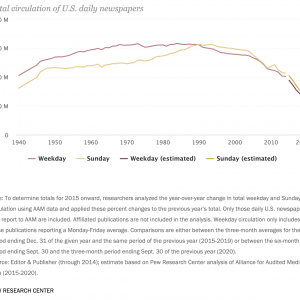Thomas Jefferson believed that the transparency provided by journalism was virtually a fourth branch of government, serving as a check and balance on the constitutionally-defined three. But he also recognized that the news must be available to all, and that all Citizens must be able to understand the news that is published (implying a minimum level of education).
Subscriptions violate both these important considerations. The poor cannot afford to pay for economically regressive subscriptions, and therefore do not have access to the same quality news as the wealthy. This deficit is perpetuated when their children do not grow up with quality news from which to learn about their rights and best interests under American democracy. For these reasons subscriptions for news may be the most economically-divisive commercial concept under the American economy and political system.
Subscriptions farther out of Reach
Since the turn of the century the newspaper industry, and to a lesser extent electronic news broadcasting, have lost both the majority of their audiences, and their advertising revenue.
Total estimated weekday circulation of U.S. daily newspapers was 55.8 million in 2000 and dropped to 24.2 million by 2020, according to Editor & Publisher and the Pew Research Center.
As newspaper consumption declined this century, the news product became uncompetitive, with the exploding search and social media digital products gobbling up news media’s lunch, while also creating a new medium which has co-opted and corrupted the very concept of trustworthy journalism.
The advertising revenue for newspapers peaked in 2005 just before the iPhone and social media emerged, an event to which news media was unable to effectively respond to maintain a sustainable news ecosystem. The following graph shows how the industry lost the vast majority of ad revenue in the last 15 years.
While the industry lost over 60% of its ad revenue, circulation revenue continue to grow at a much slower pace, not nearly replacing the ad revenue decline.
It doesn’t take complex math to see that when circulation dropped by more than half and circulation revenue increased only slightly the amount each Citizen pays for newspapers has more than doubled in the last 15 years.
Quality news is not becoming more accessible through affordability, it is becoming less so.
This fact, combined with the erosion in the number of newspapers, journalists, and communities with any news coverage has meant that access to quality news is limited well beyond the rising cost of subscriptions.
In Jefferson’s time early newspapers were growing in number, circulation and diversity of opinion. He and the other founding fathers cannot be faulted for not better planning for the sustainability and universal access of news media in their drafting of the US Constitution. However, it is clear they would have done so under today’s dire circumstances for news media and American democracy.


